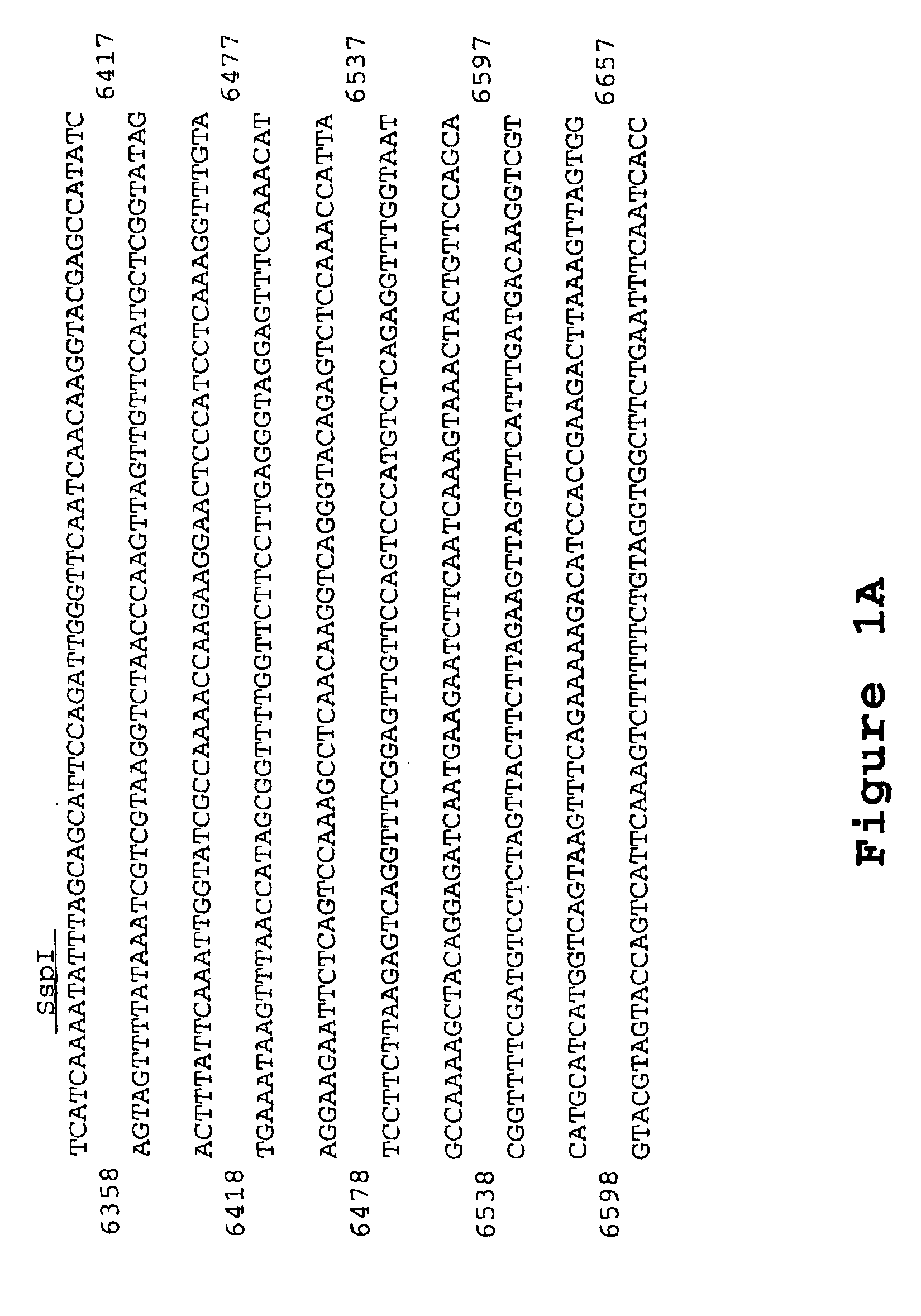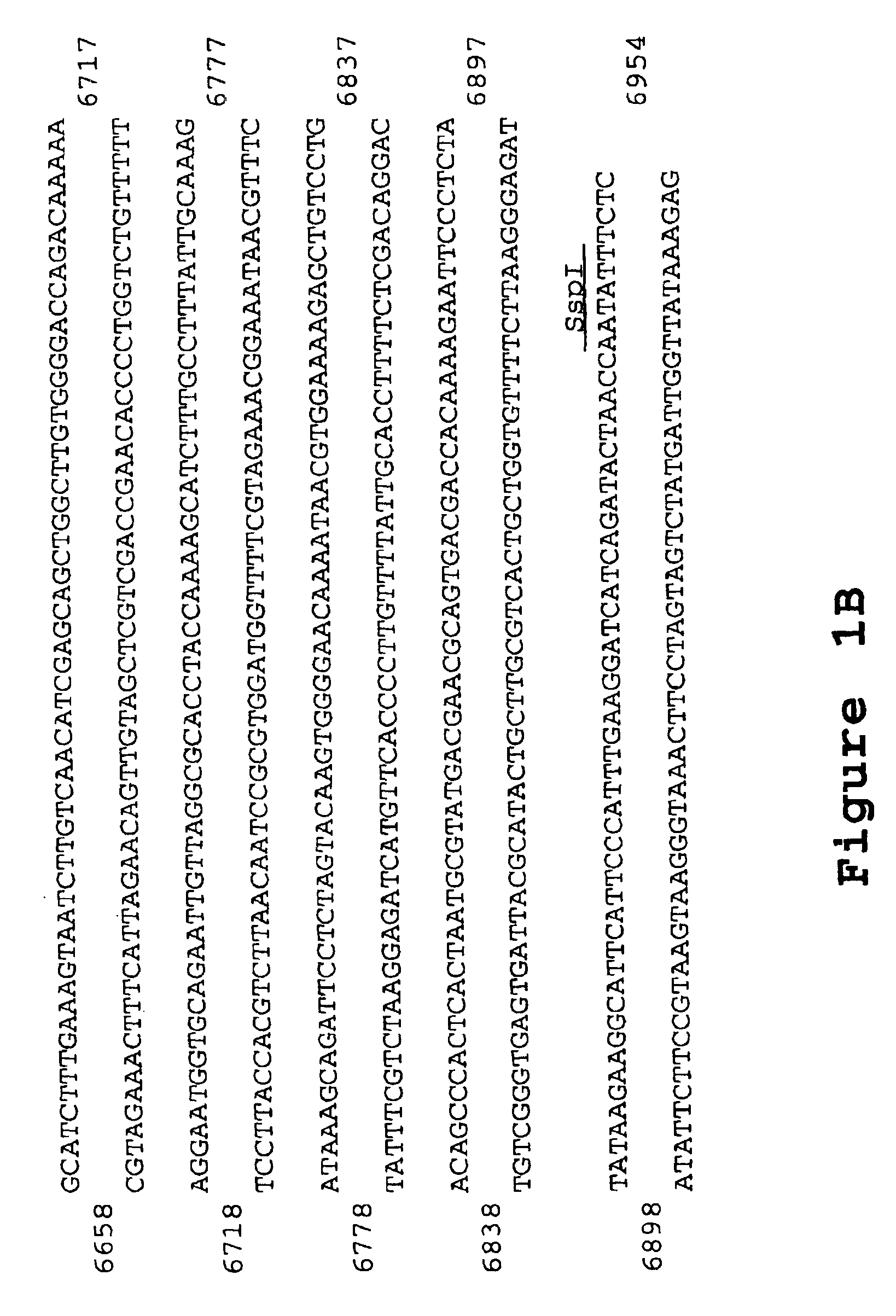Glyphosate-tolerant 5-enolpyruvylshikimate-3-phosphate synthases
a technology of pyruvyl shikimate and phosphate, which is applied in the field of plant molecular biology, can solve the problems of lowering the catalytic efficiency (vsub>max/sub>/ksub>m/sub>) of the enzyme, and achieves the effect of reducing the amount of overproduction and glyphosate toleran
- Summary
- Abstract
- Description
- Claims
- Application Information
AI Technical Summary
Benefits of technology
Problems solved by technology
Method used
Image
Examples
example 1
[0213]Transformed tobacco plants have been generated with a number of the Class II EPSPS gene vectors containing the CP4 EPSPS DNA sequence as described above with suitable expression of the EPSPS. These transformed plants exhibit glyphosate tolerance imparted by the Class II CP4 EPSPS.
[0214]Transformation of tobacco employs the tobacco leaf disc transformation protocol which utilizes healthy leaf tissue about 1 month old. After a 15-20 minutes surface sterilization with 10% Clorox plus a surfactant, the leaves are rinsed 3 times in sterile water. Using a sterile paper punch, leaf discs are punched and placed upside down on MS104 media (MS salts 4.3 g / l, sucrose 30 g / l, B5vitamins 500×2 ml / l, NAA 0.1 mg / l, and BA 1.0 mg / l) for a 1 day preculture.
[0215]The discs are then inoculated with an overnight culture of a disarmed Agrobacterium ABI strain containing the subject vector that had been diluted 1 / 5 (i.e.: about 0.6 OD). The inoculation is done by placing the discs in centrifuge tub...
example 2a
[0221]Canola plants were transformed with the pMON17110, pMON17116, and pMON17131 vectors and a number of plant lines of the transformed canola were obtained which exhibit glyphosate tolerance.
Plant Material
[0222]Seedlings of Brassica napus cv Westar were established in 2 inch (˜5 cm) pots containing Metro Mix 350. They were grown in a growth chabmer at 24° C., 16 / 8 hour photoperiod, light intensity of 400 μEm−2sec−1 (HID lamps). They were fertilized with Peters 20-10-20 General Purpose Special. After 2½ weeks they were transplanted to 6 inch (˜15 cm) pots and grown in a growth chamber at 15° / 10° C. day / night temperature, 16 / 8 hour photoperiod, light intensity of 800 uEm−2sec−1 (HID lamps). They were fertilized with Peters 15-30-15 Hi-Phos Special.
Transformation / Selection / Regeneration
[0223]Four terminal internodes from plants just prior to bolting or in the process of bolting but before flowering were removed and surfaced sterilized in 70% v / v ethanol for 1 minute, 2% w / v sodium hyp...
example 2b
[0249]The construction of two plant transformation vectors and the transformation procedures used to produce glyphosate-tolerant canola plants are described in this example The vectors, pMON17209 and pMON17237, were used to generate transgenic glyphosate-tolerant canola lines. The vectors each contain the gene encoding the 5-enol-pyruvyl-shikimate-3-phosphate synthase (EPSPS) from Agrobacterium sp. strain CP4. The vectors also contain either the gox gene encoding the glyphosate oxidoreductase enzyme (GOX) from Achromobacter sp. strain LBAA (Barry et al., 1992) or the gene encoding a variant of GOX (GOX v.247) which displays improved catalytic properties. These enzymes convert glyphosate to aminomethylphosphonic acid and glyoxylate and protect the plant from damage by the metabolic inactivation of glyphosate. The combined result of providing an alternative, resistant EPSPS enzyme and the metabolism of glyphosate produces transgenic plants with enhanced tolerance to glyphosate
[0250]Mo...
PUM
| Property | Measurement | Unit |
|---|---|---|
| pH | aaaaa | aaaaa |
| pH | aaaaa | aaaaa |
| pH | aaaaa | aaaaa |
Abstract
Description
Claims
Application Information
 Login to View More
Login to View More - R&D
- Intellectual Property
- Life Sciences
- Materials
- Tech Scout
- Unparalleled Data Quality
- Higher Quality Content
- 60% Fewer Hallucinations
Browse by: Latest US Patents, China's latest patents, Technical Efficacy Thesaurus, Application Domain, Technology Topic, Popular Technical Reports.
© 2025 PatSnap. All rights reserved.Legal|Privacy policy|Modern Slavery Act Transparency Statement|Sitemap|About US| Contact US: help@patsnap.com



